Yesterday after several weeks of foul weather, inversions and poor light we finally had a nice morning with clear air and sunshine so I spent the morning at Farmington Bay. I didn’t find many birds but I sure had fun with this adult White-crowned Sparrow.
Sorry, I ran out of time to include full image techs. Most photos are in the range of 1/3200, f/6.3, ISO 500, Canon 7D Mark II, Canon EF 500mm f/4L IS II USM + EF 1.4 III Extender. The background in these images is the water of Glover Pond.
I found ‘him’ feeding on top of a phragmites seed head.
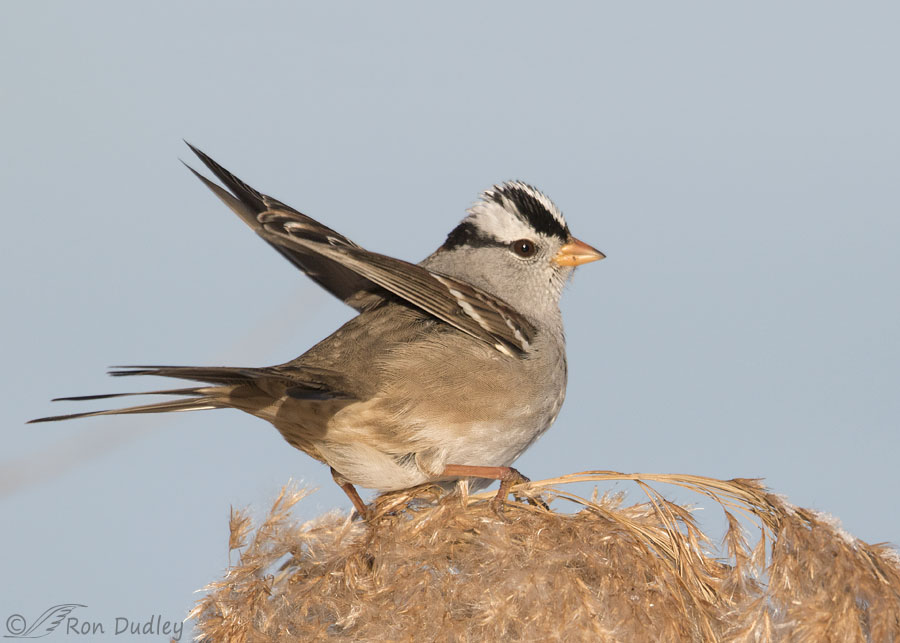
He was such a glutton this might be the most interesting pose I got because he spent the entire time gorging himself on the seeds.
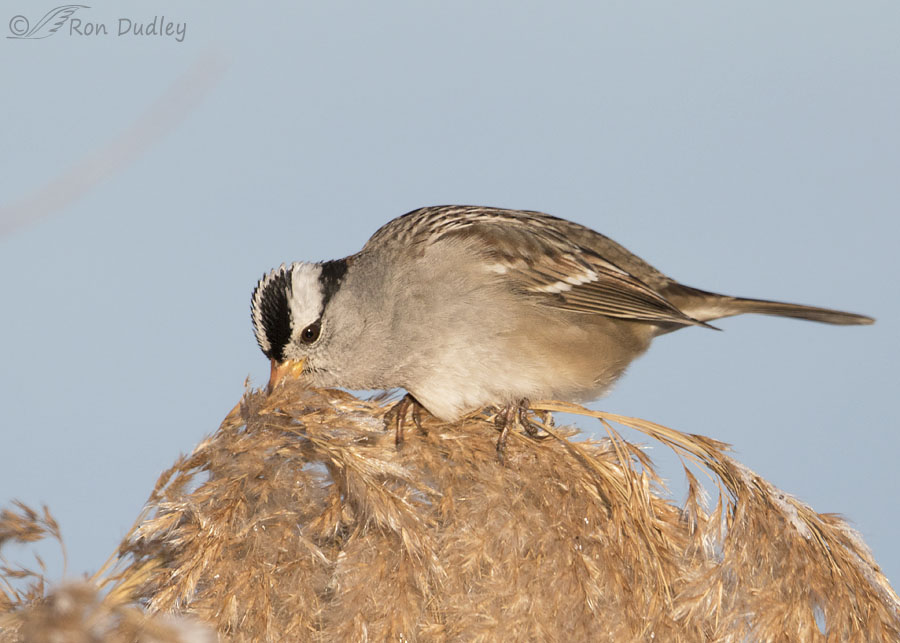
The individual seeds are tiny – each phragmites seed head can produce about 2000 of them per year so…
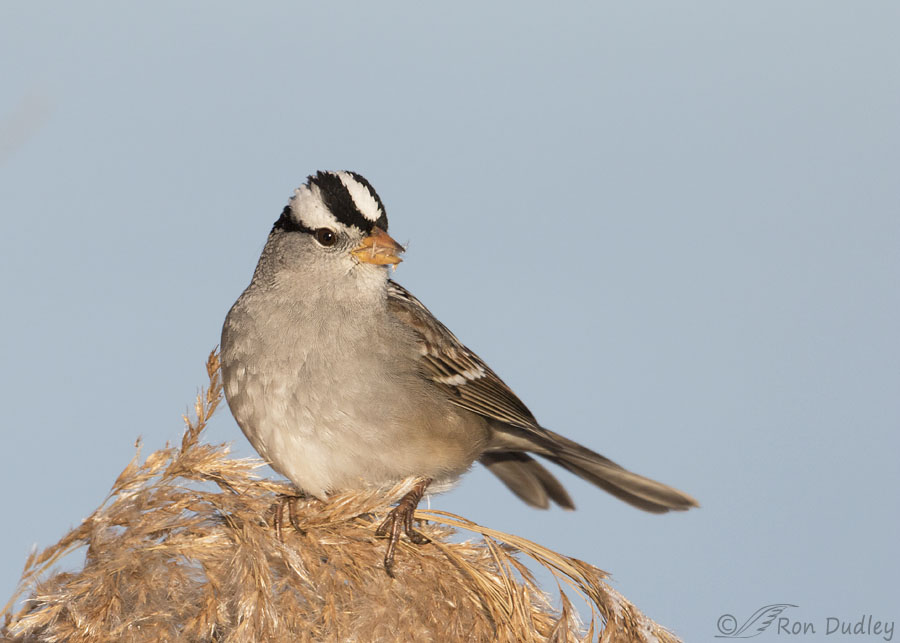
this sparrow and several others nearby were taking full advantage of their abundance.
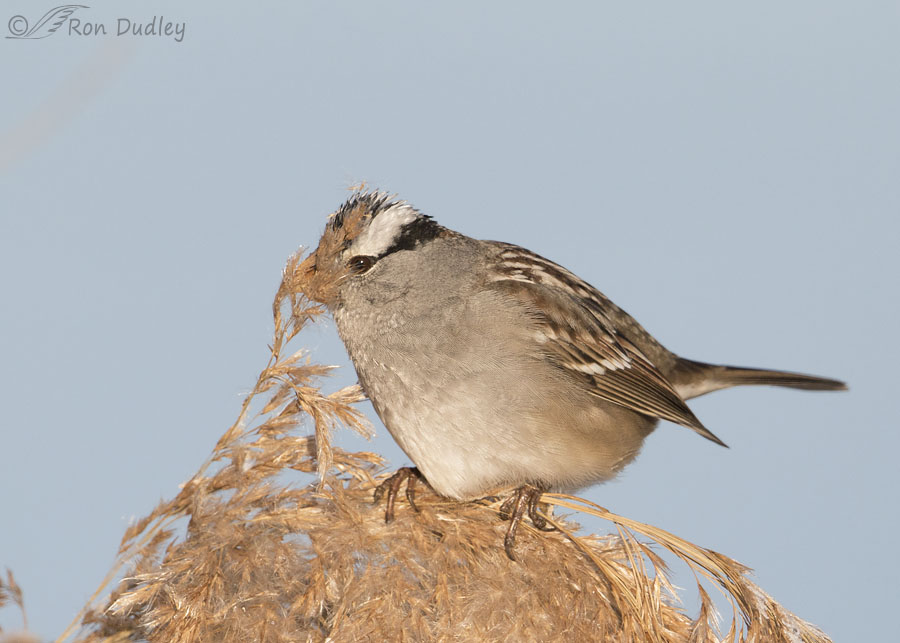
He really got into it, figuratively and literally.
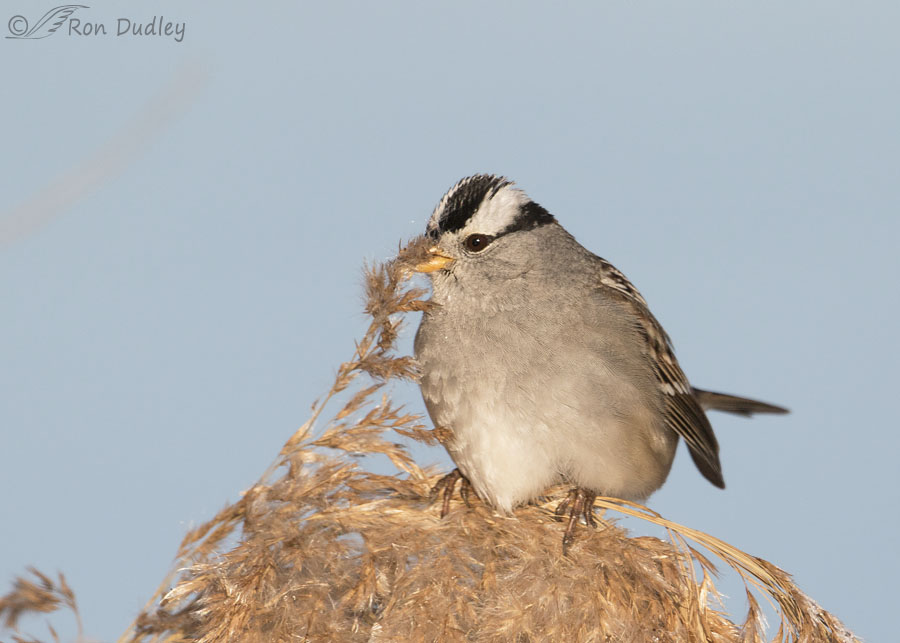
He tugged on this stem for quite a while before he got what he was after…
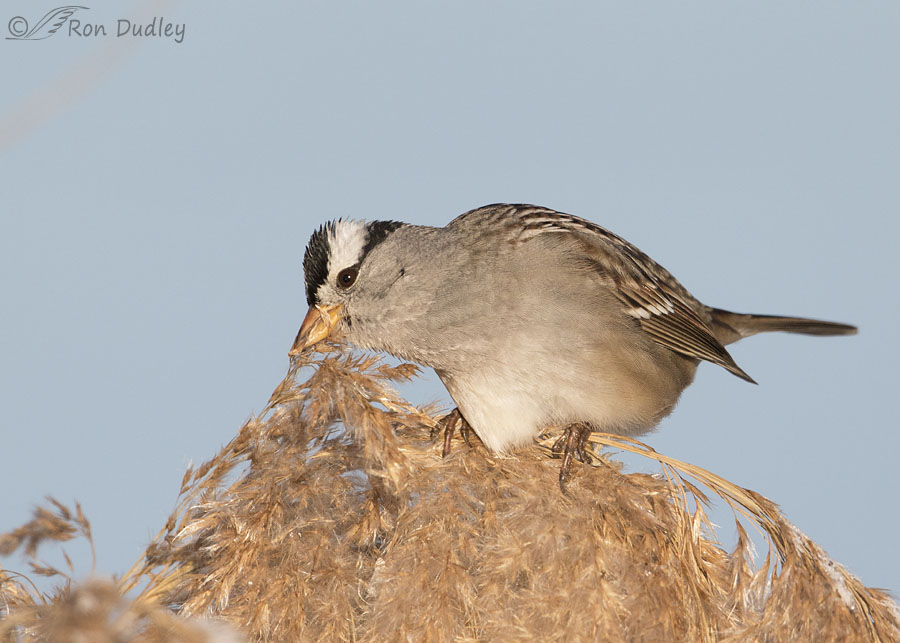
and then he went after more.
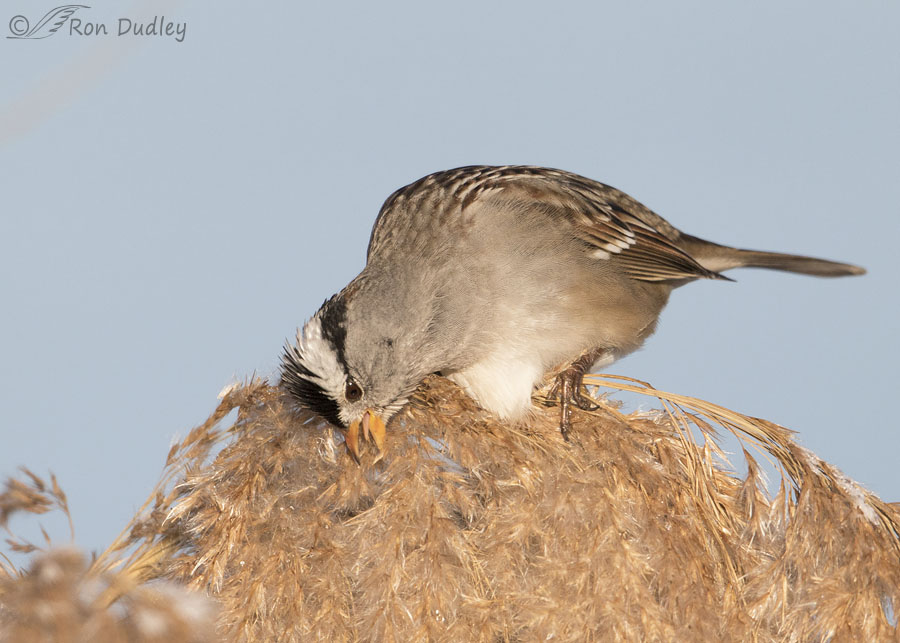
Those little seeds seemed to be everywhere but they were sure hard for me to see.
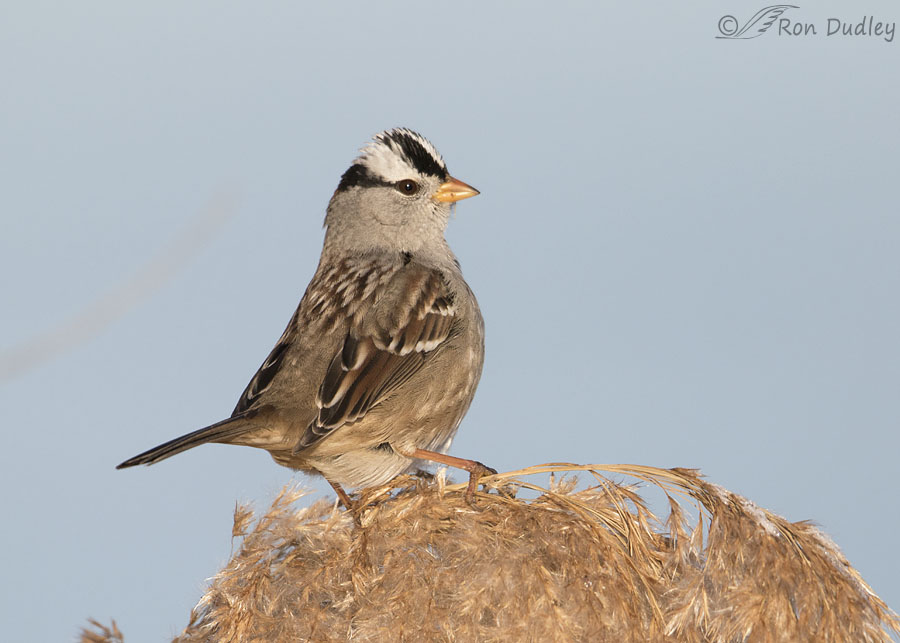
Eventually he turned on the perch…
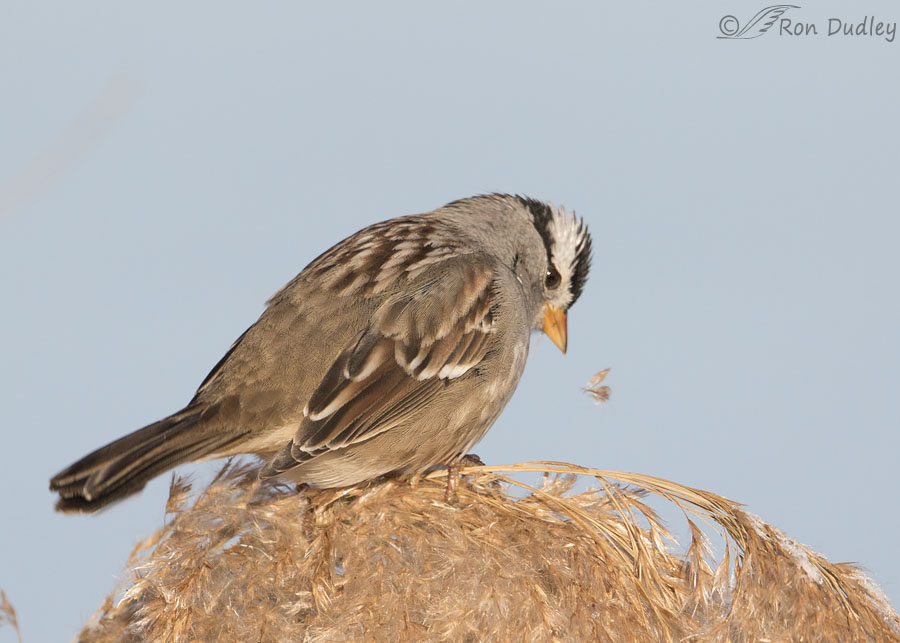
and started feeding on the other side. I had to include this shot, just because I thought it was cute as he watched the phragmites fluff fall. I took about 400 shots of this sparrow over less than four minutes as he was eating and would have continued if another vehicle hadn’t approached me from behind and forced me to leave it.
I’ve wondered about something regarding phragmites for a very long time and my experience with these sparrows yesterday morning brought the question to the forefront once again. What’s the real reason phragmites in North America has been disparaged by wetland and refuge managers for so long? And does it really deserve its nasty reputation as an invasive species that “should be removed at any cost” because it has few if any environmental virtues in North America?
Although the Phragmites australis found in North America is commonly considered a foreign and invasive species we’ve now learned from the fossil and archeological record that it’s been here for at least 3000 years. From my own experience I know it provides useful habitat for a variety of vertebrate and invertebrate species including birds and mammals.
Land managers have historically thought of phragmites marshes as being “barren of plants and wildlife, particularly waterfowl.” But actual evidence of that belief is thin and inconsistent. Here’s part of what the USDA’s Natural Resource Conservation Service says about Phragmites australis, also known as common reed:
- Phragmites australis provides “excellent cover for wildlife including hiding cover for deer, rabbits, pheasants and other animals. Common reed also provides nesting cover for wide variety of waterfowl and shoreline birds. Waterfowl eat the seed, and muskrats and nutrias eat the rhizomes and stems”
But the issue is complicated by the following factors: there are multiple varieties of Phragmites australis (all of them the same species), some are native to North America and some are not, they can be extremely difficult to distinguish from each other and it’s the invasive varieties that are causing the alleged problems.
From my own observations over many years it’s obvious to me that phragmites provides useful habitat and cover for a large variety of native vertebrate species and many birds and mammals use their seeds, rhizomes and stems as a food source.
But the war on phragmites in our wetlands and marshes continues unabated. Many millions of dollars and endless man hours are spent on its eradication annually and I’m continually seeing evidence of that effort at places like Bear River MBR and Farmington Bay WMA where they burn, plow, graze cattle and use a variety of other methods and expensive equipment in an effort to control it. And they never seem to make any lasting progress.
Invasive varieties of phragmites may or may not be the environmental scourge they’ve been thought to be – the evidence is still unclear. So several questions beg to be asked: Should the war on phragmites’ continue as we’ve been fighting (and losing) it or would our resources be better spent on other methods of wetland management? And why have land managers, refuge managers in particular, been and continue to be so consistent in their dislike of phragmites and their efforts to control it? I have my own working theory about the answer to that last question – it goes something like this.
In my opinion there’s no question that hunters and hunting are the driving force behind many wildlife and bird “refuges” and that’s true to an unwarranted degree (which is related to the reason I refuse to buy a duck stamp but that’s a story for another post). Many refuges have almost become waterfowl (ducks and geese) farming operations for the benefit of hunters which means that non-consumptive users of refuges such as nature lovers, birders, photographers etc. and many other native species such as predators are left to suck the hind teat. Native predators are routinely “controlled” (we know what that means…) on many refuges because of their perceived threat to waterfowl.
And phragmites marshes have long been considered “barren of waterfowl” so refuge managers continue to wage relentless and expensive war on phragmites, in part because they’ve “always done it”, when it’s obvious that the war cannot be won and it’s very possible that resources could be spent on more effective methods of marsh management. Throw in the fact that native muskrats eat phragmites intensively when it’s available and they’re notorious for tunneling into refuge dikes and making refuge management more difficult so getting rid of phragmites may also help to control muskrats and reduce headaches for refuge managers.
The issue of phragmites control is controversial and far too complex for complete coverage here but here’s an excellent summary if you have the interest.
Ron
PS – The last several paragraphs about hunting and refuge management are “just my opinion” based on my observations and understanding. I’m sure there are others…


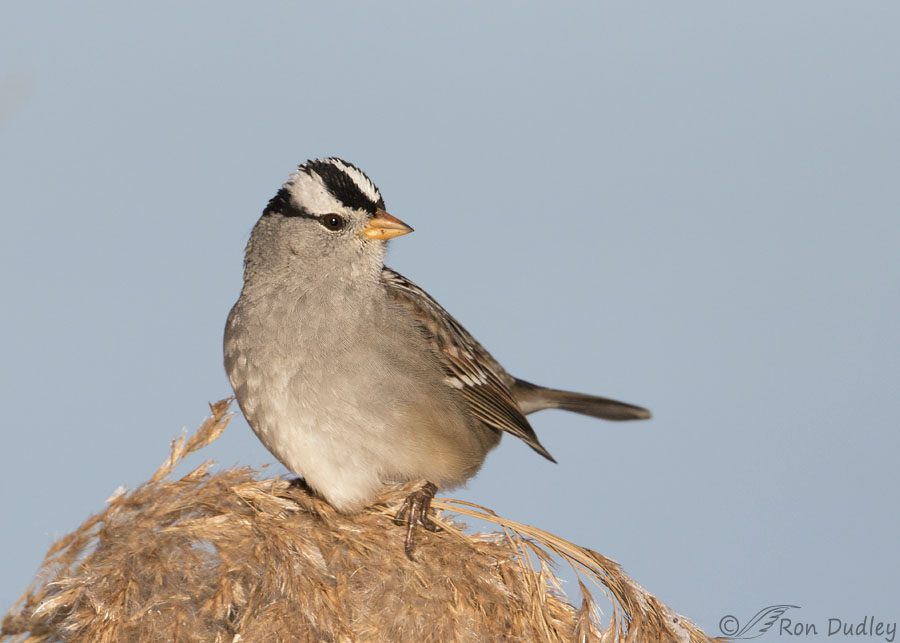
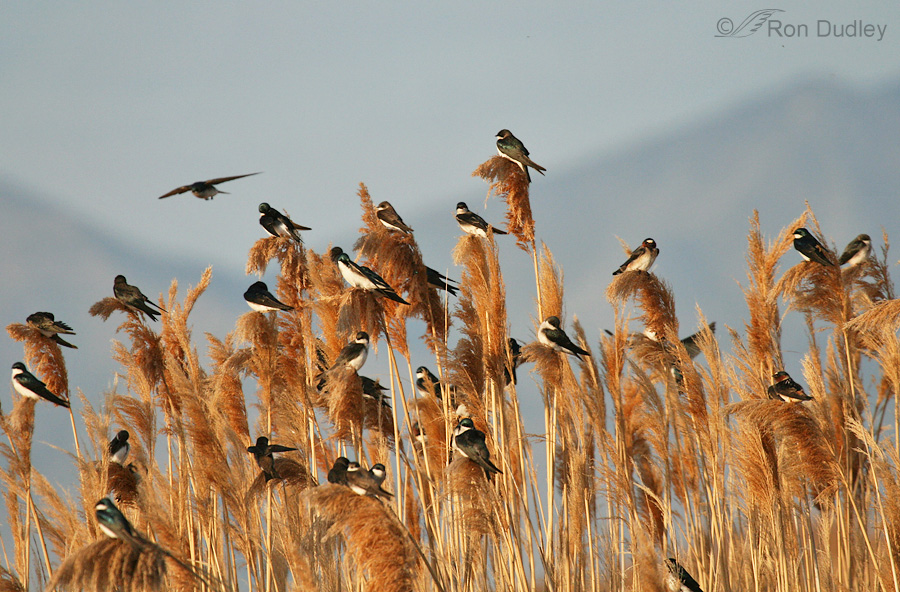
lovely as usual, they are beautiful birds. I too noticed many last visit to FBWM area. You have peaked my interest now in phragmite control. My understanding for the phrag control is that the phrags cover all open water creating a floating mat over the water preventing natural plants access for growth and using all available water up in sensitive dry areas.
Yes, sadly, almost the only way to get traction for responsible environmental policy generally requires linking it to some powerful economic contingent; in this case the hunting (and gun) interest groups. One of the most discouraging parts of public policy is how seldom we choose to do something because it is the right and responsible thing as opposed to the economically advantageous thing.
The whole topic (and definitions) of “invasive species” could consume volumes. I fall firmly on the side of agreeing with most of your points here but I’d add a few thoughts.
RE: Invasives as positives…every week for 6 years I have spent a few hours walking a 3 hectare native grassland restoration project on a river floodplain in my community. I now know the flora and fauna there very well. Using common vegetation monitoring methods we also know how our efforts at planting desired species and removing undesired ones is having some effect at moving the area toward a more diverse, more “native-like” state. But still I’m always torn when I see large flocks of sparrows and finches feeding off the Milk Thistle seed heads. I’ve manually removed tons of the stuff from the site. Yet this particular invasive feeds a lot of LBB’s through our mild California winters. And what about all those native bee species I document on Star Thistle through the hottest summer days? And what about that European Honey Bee (a competitive introduced species) we all know and love?
RE: The power of the hunting interests…there’s no doubt their influence out-weighs that of birders, photographers and the average un-armed nature appreciator (and not always for the better) but in my locality were it not for the substantial sums of conservation dollars Ducks Unlimited generates we would not have one of the most beautiful and expansive riparian wildlife sanctuaries in the San Joaquin Valley–The Cosumnes River Reserve between Sacramento and Stockton. It is an extremely popular site used exclusively by non-hunting nature lovers and educators and including several working farms that bought into the conservation/education mission. It is also a major Sandhill Crane wintering site.
RE: “They’ve always done it.” On the restoration site I mentioned above–come mid-June–our County’s levee maintenance mowers show up. Before we approached them and asked if they could simply modify their paths to avoid some sensitive areas on our site they ran 16′ wide mowing rigs over the entire floodplain every April-June. Tractor operators told me this includes several hundred miles of levee. One justification I heard was fire control. I can see that. Once the annual grasses dry completely there have been fires…especially since the population of homeless folks along the river through town has grown. Another rationale is weed control but my own observations on the site contradicts that one. Cut the non-native annual grasses down to two inches and instead of growing back to 10 inches to seed they will put out seed at 1 1/2 inches…just like your lawn. The third reason for the mowing (and I believe the main one)? “We’ve always done it.”
Sorry to run on so but your post could be un-packed in at least a thousand other equally interesting ways. The native vs non-native vs non-native invasive debate stream is deep, wide and well worth limning. Thanks for dipping into it.
And thanks for taking the plunge yourself, James.
Like I said it’s a complicated subject. I’ll respond to one point you made in particular. There’s no question that Ducks Unlimited and some other hunting-related organizations (and hunting related policies like the Pittman-Robertson Act) have historically had huge positive impacts on waterfowl and habitat that we still enjoy today.
But I’m of the strong opinion that hunters wield much more influence on the way refuges and wetlands are managed today than they should, especially in the western states. And the rest of us wield much too little.
Thanks for the lesson and also for the linked reference Ron. I happen to agree with your opinion(s).
Thanks, Art. Then perhaps they even have some merit!
I suspect that gorgeous glutton (and many others) was intensely grateful for a prolific food site at a time when food is likely becoming harder to find.
And found the article fascinating.
There is so much (on so many subjects) we don’t know definitively – but continue to behave as if we do.
He seemed pretty happy (and enthusiastic) to be doing what he was doing, EC. Thanks.
1. The bird shots: I deeply enjoy them, especially the flock of feeders in the fragmites (I had to, didn’t I?)
2. Phragmites: around here, we have changed our categorization from invasive to inconclusive https://www.cal-ipc.org/plants/profile/phragmites-australis-profile/. The problem is that it is flammable as hell, and there are still nurseries that sell the stuff as pond plants and privacy screens.
Wow, I didn’t know that nurseries sold them, Martha. I wonder if they can sell the invasive varieties.
Good question. I’m having UC Master Gardeners check into it.
What a persistent little fella! Glad you both were rewarded for getting out among ’em early. Love the full mouth shot as well as the caucus meeting on the phragmites (what kind of birds are they?).
Thank you for including the link. To be perfectly honest, I may not read it this time. After the dim environmental news this week, I’m thinking that my desire to not get pissed off may win over my desire to learn something new.
They’re Cliff Sparrows at Bear River MBR, Marty. They love to roost on phrags and launch from them on their insect forays.
Thank you for this. I do love learning. And what a handsome fella he is.
Thanks, Arwen. I think the adults are among the most handsome and distinctive of sparrows.
He sure is a saucy little fellow.
I’m with Everett and will read this in full later today when I have the time.
Thanks for this great series.
I hope you can find the time, Dave.
Wonderful series Ron!
Charlotte
Thanks, Charlotte.
One of the really cute sparrows! In all my travels about birding, I rarely see flocks of birds on phragmites as your last photo, only an occasional bird. That is a refreshing site…I’ve always thought with all those seeds more birds should be consuming them. This is an issue here in Wisconsin also along with ‘reed canary grass’ (Phalaris arundinacea) and cattails ( Typha latifolia, T. angstifolia, and T. x glauca a hybrid fo the two). Only latifolia being the good guy and it is hard to distinguish between them. Irradications borders being nearly impossible it seems for any of these and throw in teasel which I have found to be a magnet for most species of butterflies when in bloom. Good guys…bad guys, the battle goes on. I think the only thing that can be agreed upon is that it is a ‘complex issue’ and there will always be alien species being introduced and probably few will ever be controlled…e.g. Emerald Ash Borer. OK…off my soapbox…
“I think the only thing that can be agreed upon is that it is a ‘complex issue’”
I suspect you’re right, Kathy. Thanks.
Wow Ron, what an education on phragmites – a word I must admit to never ever seeing or hearing. I will read in full later this morning. The White-crowned Sparrow wanted to fill up for the winter all in one morning. Good series – thanks for posting.
Everett Sanborn, Prescott AZ
Thank you, Everett. It’s a complex and controversial subject…
Cute series of the sparrow – nice to be able to get clear shots of him/her pigging out! Always “competing interests” when it comes to land management it seems. Eco systems evolve and change over time no matter what we do and, generally, wildlife adapts and, where possible, take advantage of whatever they can. No answers for sure – on going battle with Canada Thistle (goldfinches love it) and other “weeds”……
Always “competing interests” when it comes to land management it seems. Eco systems evolve and change over time no matter what we do and, generally, wildlife adapts and, where possible, take advantage of whatever they can. No answers for sure – on going battle with Canada Thistle (goldfinches love it) and other “weeds”……
Boy, do I ever remember what we called “Canadian thistle” on the Montana farm. Once a patch of it got started in a field it was almost impossible to get rid of. We used to walk the fields and pull them by hand sometimes (although we usually used other methods). When you’re talking more than 1200 acres (eventually 3000+ acres) that’s a lot of walking and pulling.
LOTS of walking and an exercise in futility with their ability to regenerate from small pieces of root! Starving them out takes a LONG time as in years….
Yup!